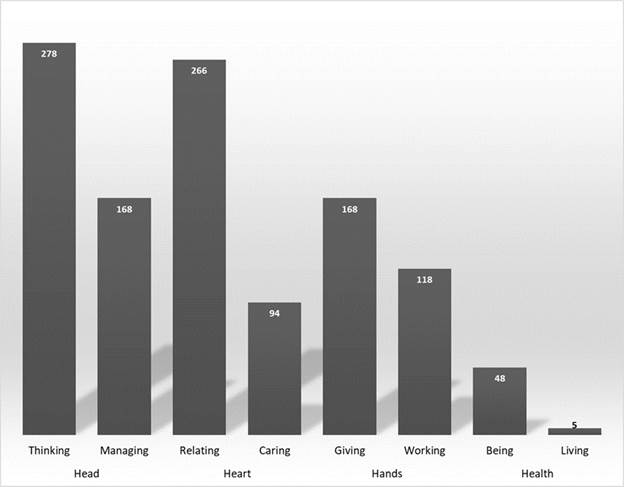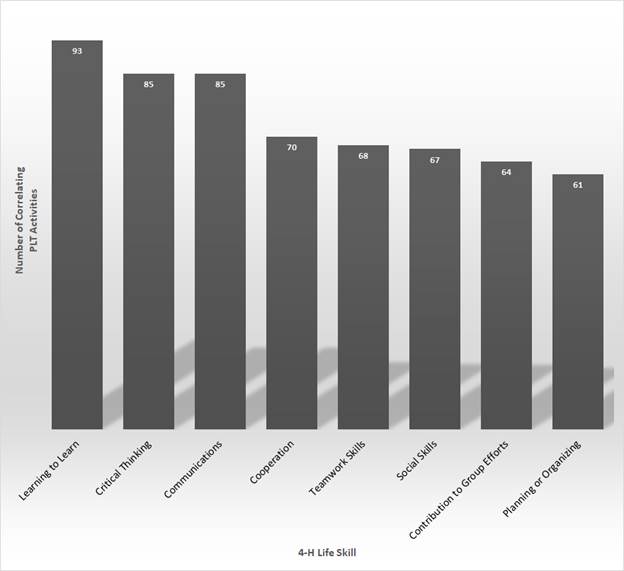 |
October 2019
|
October 2019 // Volume 57 // Number 5 // Tools of the Trade // v57-5tt6
Correlating Project Learning Tree to 4-H Life Skills: Connections and Implications
Abstract
To determine how Extension educators can use environmental education materials to develop life skills in youths, we correlated a national environmental education curriculum developed by Project Learning Tree (PLT) to the 4-H Life Skills Wheel. Youth development professionals can use the resulting correlations to determine which life skills the various PLT activities help develop. The correlation results also provide insights regarding how PLT activities help develop head, heart, and hands skills.
Background
Environmental educators and Extension educators share similar conservation and youth development goals (Smaldone, Boone, Selin, & See, 2011), and the outcomes from environmental education (EE) programs can be linked to positive youth development (Krasny, Kalbacker, Stedman, & Russ, 2015; Schusler & Krasny, 2010). Therefore, high-quality EE materials can serve as potentially valuable resources for Extension educators, especially those involved with 4-H programming.
Indeed, some state Extension programs have implemented strategies such as developing fact sheets and training programs that connect locally relevant resources to national EE curricula, thereby supporting EE curricula adoption by Extension professionals (Monroe, 2012). However, nationally recognized EE curricula, including Project Learning Tree (PLT), Project WILD, and Project WET, are not correlated to the 4-H Life Skills Wheel developed by Hendricks in 1998. This wheel serves as a guiding framework for 4-H educators in the development and evaluation of programming (Fitzpatrick, Gagne, Jones, Lobley, & Phelps, 2005).
To determine how a nationally recognized EE curriculum supports the development of life skills identified in the 4-H Life Skills Wheel, our team, which included nine Extension and environmental educators from six states, developed correlations between the 4-H life skills and the activities in PLT PreK-8 Environmental Education Activity Guide (PLT PreK-8 Guide). The PLT PreK-8 Guide is an award-winning international EE curriculum that meets the North American Association for Environmental Education's Guidelines for Excellence in Environmental Education.
Our goal was to correlate each of the 96 activities in the PLT PreK-8 Guide to the skills from the 4-H Life Skills Wheel, which are listed in Table 1. Extension professionals can use the resulting correlations to determine the specific life skills that PLT activities help foster.
| 4-H category | Subcategory | Life skills |
|---|---|---|
| Head | Thinking |
Learning to learn Decision making Problem solving Critical thinking Service learning |
| Managing |
Goal setting Planning/organizing Wise use of resources Keeping records Resiliency |
|
| Heart | Relating |
Communications Cooperation Social Skills Conflict resolution Accepting differences |
| Caring |
Concern for others Empathy Sharing Nurturing relationships |
|
| Hands | Giving |
Community service/volunteering Leadership Responsible citizenship Contribution to group efforts |
| Working |
Marketable/useful skills Teamwork Self-motivation |
|
| Health | Being |
Self-esteem Self-responsibility Character Managing feelings Self-discipline |
| Living |
Healthy lifestyle choices Stress management Disease prevention Personal safety |
|
| Adapted from "Developing Youth Curriculum Using the Targeting Life Skills Model: Incorporating Developmentally Appropriate Learning Opportunities to Assess Impact of Life Skill Development," by P. A. Hendricks, 1998. Copyright 1998 by Iowa State University. Adapted with permission. | ||
Process for Correlating PLT Activities and 4-H Life Skills
Before beginning the correlation work, our team established interrater reliability by conducting an initial correlation in which each researcher on the team independently correlated the same three PLT activities to the 4-H life skills. It was important to establish interrater reliability to ensure that we were consistent in our correlations of PLT activities to 4-H life skills. For this initial correlation, we discussed via conference call how to complete the correlations between the PLT activities and the 4-H life skills. Then we reviewed each PLT activity and identified all the life skills the activity helps develop. We marked in an Excel spreadsheet whether the activity had no correlation, a partial correlation, or a strong correlation to each 4-H life skill.
An analysis of the initial correlations determined the level of agreement (as a percentage) among our team members for the correlation of a given activity to each life skill. Our lead researcher determined that five life skill correlations had less than 70% agreement among our team members for two or three activities. For example, in the case of the skill learning to learn, fewer than 70% of us agreed on the correlation between a specific activity and this life skill for two of the three activities used in the initial correlation. We discussed via conference call how to complete the correlations for those five life skills.
Two or three researchers worked together as teams to complete the correlations. Each team correlated 23 PLT activities to the 4-H life skills. Each team followed the correlation development procedure outlined in Table 2 to complete the correlations.
| Action | Procedure |
|---|---|
| Review life skill definitions | The 4-H Life Skills Sheets (Moyses, 2013) provided consistent definitions of each life skill. |
| Check identical/similar skills |
The following skills are identical or similar in the PLT Skills Indexa and the 4-H Life Skills Wheel:
|
| Review PLT activity | Researchers on the team reviewed the entire PLT activity, including the variationb and enrichmentc sections, before correlating the activity with life skills. If only the variation or enrichment sections of an activity correlated to a life skill, this was noted in the correlations document. |
| Choose a correlation level | Each activity was marked as having no correlation, partial correlation, or strong correlation to a given life skill. |
| Complete correlations process | Our team members individually developed their correlations, then compared their individual correlations and reached a consensus on any that differed. Our lead researcher reviewed and compiled each team's final correlations. |
| aThe PLT Skills Index identifies the skills developed by each PLT activity. The skills identified in the index come from the Association for Supervision and Curriculum Development and the American Association for the Advancement of Sciences skills lists. bPLT activities may contain a variation, which is an alternate procedure for doing the activity. The variations have similar objectives to the core activity but appeal to different age levels, learning styles, audiences, situations, or concerns. cPLT activities may contain enrichments, which are recommendations for exercises that enrich or extend the learning experience in the activity. | |
Results
The resulting correlations revealed that many of the PLT activities support the development of life skills in youths, particularly those in the subcategories of thinking, relating, managing, and giving. Fewer PLT activities support the development of skills in the caring, working, and being subcategories, and very few activities support the development of healthy living skills.
Figure 1 shows the number of PLT activities correlated to the 4-H life skills in each of the eight 4-H Life Skills Wheel subcategories. These correlation numbers represent the total number of correlations between each of the 96 PLT activities and the life skills in each subcategory of the 4-H Life Skills Wheel.
Figure 1.
Number of Correlations Between Project Learning Tree (PLT) Activities and Skills in 4-H Life Skills Wheel Subcategories

Figure 2 identifies life skills developed by at least 60 of the 96 PLT activities. Almost all the PLT activities (93 activities, or 97%) help youth develop the 4-H skill learning to learn, and 85 activities (89%) help build the skills critical thinking and communications.
Figure 2.
Number of Project Learning Tree (PLT) Activities Correlating to Specific 4-H Life Skills

Finally, an analysis of the number of life skills to which each PLT activity correlates revealed that 17 PLT activities correlate to 50% or more of the 4-H life skills. In addition, 47 PLT activities correlate to 25%–49% of the 4-H life skills. However, 32 activities correlate to fewer than 25% of the life skills.
Implications for Extension
Our work shows that Extension educators can generally rely on PLT activities to build skills related to the head, heart, and hands aspects of the 4-H mission. On the other hand, very few of the PLT activities will help educators develop health-related life skills.
The connections to head and hands life skills are expected. Previous research has demonstrated the connection between EE and academic skills associated with cognition, such as decision making and critical thinking (Ardoin, Bowers, Roth, & Holthuis, 2018; Ernst & Monroe, 2004). Likewise, research has confirmed that EE develops community and civic engagement skills, which are associated with the hands aspect of 4-H (Ardoin et al., 2018; North American Association for Environmental Education, 2017; Schusler, Krasny, Peters, & Decker, 2009).
Worth noting are the strong correlations between PLT activities and the heart skills, as the connection between EE and these skills has less support in the literature. When completing PLT activities, youths often work together in groups, where they can develop heart skills such as communications, cooperation, social skills, and conflict resolution.
Extension educators who are interested in using PLT activities to develop 4-H life skills now have a tool that allows them to quickly determine what skills each activity develops. The completed correlations tool is available at https://www.plt.org/wp-content/uploads/pdf/PLT-Correlations-to-4-H-Life-Skills.pdf.
Acknowledgments
We would like to thank the following individuals who served as correlators for our project: Linda Carnell, PLT state coordinator, West Virginia Division of Forestry; Katherine Jaeger, Extension field specialist I—youth outdoor education, South Dakota State University Extension; Heather Kent, northwest regional specialized 4-H agent, University of Florida Extension; Kristen Poppell, 4-H youth development agent, University of Florida Extension; Tracy Sigdestad, PLT state coordinator, South Dakota Project Learning Tree; Kathy Smith, forestry program director, The Ohio State University; and Marne Titchenell, wildlife program specialist, The Ohio State University.
References
Ardoin, N., Bowers, A., Roth, N., & Holthuis, N. (2018). Environmental education and K-12 student outcomes: A review and analysis of research. The Journal of Environmental Education, 49(1), 1–17.
Ernst, J., & Monroe, M. (2004). The effects of environment-based education on students' critical thinking skills and disposition toward critical thinking. Environmental Education Research, 10(4), 507–522.
Fitzpatrick, C., Gagne, K. H., Jones, R., Lobley, J., & Phelps, L. (2005). Life skills development in youth: Impact research in action. Journal of Extension, 43(3), Article 3RIB1. Available at: https://www.joe.org/joe/2005june/rb1.php
Hendricks, P. A. (1998). Developing youth curriculum using the targeting life skills model: Incorporating developmentally appropriate learning opportunities to assess impact of life skill development. Ames, IA: Iowa State University.
Krasny, M., Kalbacker, L., Stedman, R., & Russ, A. (2015). Measuring social capital among youth: Applications in environmental education. Environmental Education Research, 21(1), 1–23.
Monroe, M. (2012). Enhancing both Cooperative Extension and national environmental education resources. Journal of Extension, 50(6), Article 6IAW6. Available at: https://www.joe.org/joe/2012december/iw6.php
Moyses, K. (2013). 4-H Life Skills Sheets. East Lansing, MI: Michigan State University.
North American Association for Environmental Education. (2017). Community engagement: Guidelines for excellence. Retrieved from https://cdn.naaee.org/sites/default/files/community_engagement_-_guidelines_for_excellence.pdf
Schusler, T., & Krasny, M. (2010). Environmental action as context for youth development. The Journal of Environmental Education, 41(4), 208–223.
Schusler, T., Krasny, M., Peters, S., & Decker, D. (2009). Developing citizens and communities through youth environmental action. Environmental Education Research, 15(1), 111–127.
Smaldone, D., Boone, D. A., Selin, S., & See, A. (2011). Broadening Extension's capacity—Comparing Extension agents' and environmental educators' perceptions of needs and barriers. Journal of Extension, 49(3), Article 3FEA3. Available at: https://joe.org/joe/2011june/a3.php



